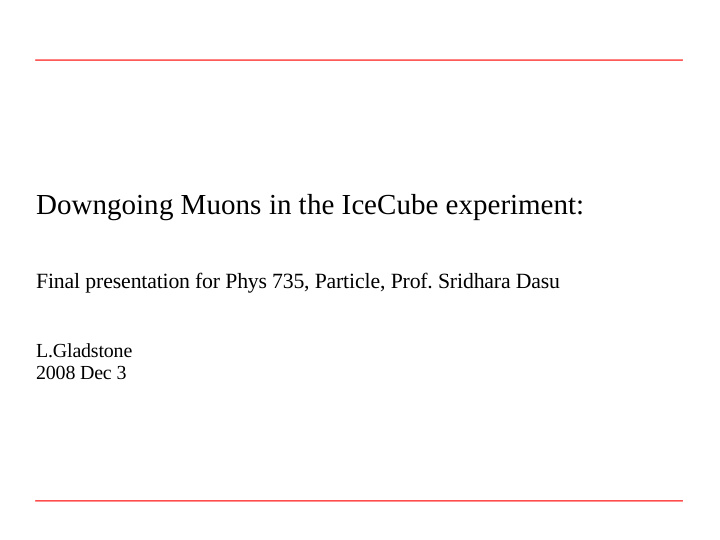



Downgoing Muons in the IceCube experiment: Final presentation for Phys 735, Particle, Prof. Sridhara Dasu L.Gladstone 2008 Dec 3
Outline Shower Basics IceCube Basics Muon Measurements: -Muon Energy Spectrum -Air Temperatures -Resolution Calibration Conclusions 3 Dec 08, particle 735 L. Gladstone, UW Madison 2
Shower Basics IceCube Basics Muon Measurements: -Muon Energy Spectrum -Air Temperatures -Resolution Calibration Conclusions 3 Dec 08, particle 735 L. Gladstone, UW Madison 3
Air Showers CR Primary Meson showers (1) meson production NN→N (π or K) (2) π +/- →μ ν μ p/nucleus (see the process from both sides of air the atmosphere) Hadronic Interaction (3)π o → γγ pion/kaon EM showers: lepton/neutrino (1) bremsstrahlung (2) pair production gamma γ→e + e - “cascading” Muons reach IC
Outline Shower Basics IceCube Basics Muon Measurements: -Muon Energy Spectrum -Air Temperatures -Resolution Calibration Conclusions 3 Dec 08, particle 735 L. Gladstone, UW Madison 5
IceCube Basics Cubic-kilometer scale Cherenkov detector Designed for neutrino astronomy – Energy: low GeV to EeV (stat. limit) – DOMs (Digital Optical Modules) point downward Main signal: – upgoing μ from astrophysical ν Antarctic (~20/hr in full detector) Muon Major background: and Neutrino – Atmospheric μ from air showers Detector – ~KHz Array – ~25Hz coincident 3 Dec 08, particle 735 L. Gladstone, UW Madison 6
Muons make visible tracks We like muons because they can penetrate the 17m between DOMs and ~125m between strings. neutrino electron, photon matter proton,neutron... tau muon a few meters
If our reconstruction were perfect... Atmospheric μ are blocked by the earth – i.e., only downgoing Signal μ from astrophysical ν can go through the earth – can be upgoing
If our reconstruction is off by a couple %... Signal ν can easily be swamped by atmospheric μ Careful reconstruction and cuts are needed – But those are the concern of ν point source talks We can use μ for calibrations!
Outline Shower Basics IceCube Basics Muon Measurements: -Muon Energy Spectrum -Air Temperatures -Resolution Calibration Conclusions
Muon Energy Spectrum IceCube is designed for highest energies IceCube gets a lot of μ flux We can extend μ flux measurements to high energies – constrain cosmic ray production models Models for HE interactions not probed in accelerators Convolve: CR spectrum (measured), CR composition, HE cross sections, => this plot Major research question From Astroparticle Physics 30 (2008) 219–233 3 Dec 08, particle 735 L. Gladstone, UW Madison 11
Outline Shower Basics IceCube Basics Muon Measurements: -Muon Energy Spectrum -Air Temperatures -Resolution Calibration Conclusions 3 Dec 08, particle 735 L. Gladstone, UW Madison 12
Atmospheric Temperature Measurements Summer atm is less dense Winder atm is colder & denser – Pi and k less likely to react with – Pi and k more likely react in atm nucleus before decay to μ or hit ground before decaying – More μ reach detector depth – Fewer μ π π π π 3 Dec 08, particle 735 L. Gladstone, UW Madison 13
Atmospheric Temperature Measurements Correlation noticed in Amanda: – Balloon flights track atmospheric temperatures daily – Amanda/IceCube records μ rate (in small bins, usually hours) H. Wissing, DESY Zeuthen
Outline Shower Basics IceCube Basics Muon Measurements: -Muon Energy Spectrum -Air Temperatures -Resolution Calibration Conclusions 3 Dec 08, particle 735 L. Gladstone, UW Madison 15
Cosmic rays Muons
Moon Shadow Data-based (simulation-independent) check of systematic errors “Standard candle” observation for gamma telescopes (HESS, Milagro etc) Easiest-to-find point source – This is the first setup of Amanda/IceCube which can see the Moon, which indicates that other point sources are now possible Δθ 5 ◦ Dummy moon for off-source measurement
Conclusions IceCube can observe a large sample of atmospheric muons Using this sample, we can measure – Muon energy spectrum – Upper atmospheric temperatures – Detector angular resolution Conclusion: downgoing muons are useful to IceCube.
Outline Shower and IceCube Basics Muon Measurements: -Muon Energy Spectrum -Large Scale Anisotropies -Air Temperatures -Resolution Calibration Conclusions 3 Dec 08, particle 735 L. Gladstone, UW Madison 19
Large Scale Anisotropies Muon anisotropies follow cosmic ray anisotropies Anisotropies only seen at low energies <10 TeV – So we map the southern sky Two major effects seen: – Heliomagnetic tail (shown below) – Galactic magnetic field effects (next slide) NB: this “major” effect is ~0.1% arXiv:astro-ph/0505114v1 3 Dec 08, particle 735 L. Gladstone, UW Madison 20
Large Scale Anisotropies The Tibet gamma array has seen an anisotropy in events (viewed in galactic coordinates) Energy dependence suggests this comes from magnetic fields (but high energy is also lower statistics, so less accurate) IceCube is looking for this effect Galactic fields are hard to map because particles bend and direct probes are impractical Highest energies have no anisotropy 3 Dec 08, particle 735 L. Gladstone, UW Madison 21
Atmospheric Temperature Measurements To look for correlation, describe atm. Temp(height) as single numbers, T eff <show animation: http://icecube.wisc.edu/~drocco/WeatherVideos/weather.gif> 3 Dec 08, particle 735 L. Gladstone, UW Madison 22
Recommend
More recommend